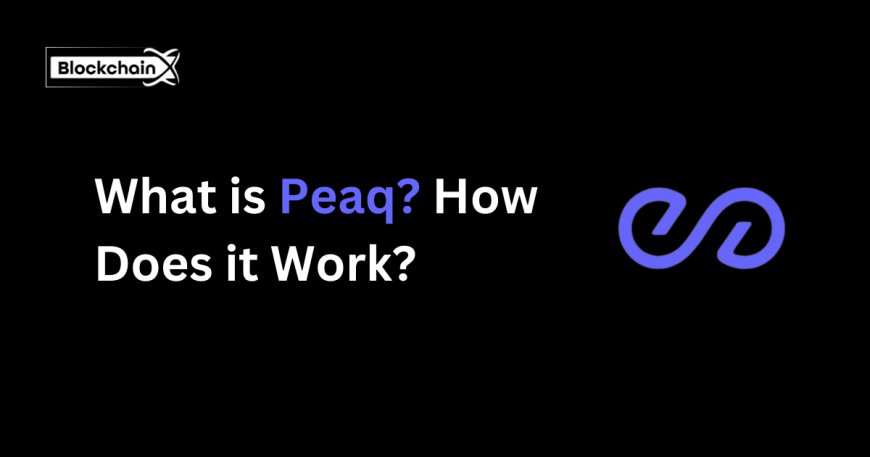What is Peaq? How Does it Work?
The multi-chain layer 1 blockchain Peaq was created for Machine RWA and DePIN. With a minimal transaction cost of about $0.00025, the Peaq blockchain network can process more than 100,000 transactions per second (TPS).
Significant change is occurring in the Internet of Things (IoT) sector. Even while connectivity is growing quickly, issues about data security, privacy, and control are still crucial. In the Web3 environment, Decentralized Physical Infrastructure Networks (DePINs) show promise as a way to establish a safe and user-centered paradigm for device interactions.
One of the main players in the DePIN revolution is Peaq Blockchain Development Network. It provides a strong blockchain layer that enables programmers to create cutting-edge DePIN apps. Let's examine Peaq's features, effects on the DePIN market, and ability to completely transform device interactions in more detail.
What is Peaq blockchain Network?
The multi-chain layer 1 blockchain Peaq was created for Machine RWA and DePIN. With a minimal transaction cost of about $0.00025, the Peaq blockchain network can process more than 100,000 transactions per second (TPS). Peaq is the second-largest developer community in Web3 and employs the greenest blockchain technology.
Peaq's Funding Significant
For a number of reasons, Peaq's US$15 million investment round is noteworthy. First of all, it confirms that DePIN has the ability to revolutionize infrastructure management. The involvement of well-known venture capital firms such as Borderless Capital and Generative Ventures indicates that investors are becoming more confident in the DePIN concept.
Second, the money will play a key role in growing the ecology of Peaq blockchain DePIN. This entails luring other projects to join the network, creating applications and tools to make network operations more efficient, and possibly even introducing its own native coin to encourage involvement. DePIN's success depends on a strong ecosystem because it encourages network effects and draws in more users.
Lastly, Peaq's funding opens the door for both its mainnet—the blockchain's central operational network—and its public debut. A successful public launch would mark a significant turning point for DePIN and perhaps spark a surge of creative real-world blockchain applications.
What are the Challenges and Future Outlook?
Even with the bright future, DePIN and Peaq still have some obstacles to overcome. One issue is that it's becoming widely used. It might take a lot of work to persuade well-established businesses used to traditional infrastructure ownership to adopt a decentralized approach. DePIN must also guarantee the network's scalability and security in order to meet demands in the real world.
Nonetheless, there is no denying DePIN's potential advantages. Streamlining infrastructure management and cutting expenses could open up new opportunities for a number of sectors. DePIN has the potential to completely transform the design and use of physical infrastructure, from data storage and telecommunications to the Internet of Things (IoT).
For DePIN, Peaq's successful investment round represents a major advancement. The upcoming months will be critical in assessing the broader adoption and practical impact of this novel approach to infrastructure management as the project moves closer to its public launch.
Use Cases of Peaq
-
Autonomous Vehicles: Vehicles equipped with Peaq blockchain can offer rides, trade charging slots, and generate revenue autonomously.
-
Smart Cities: Devices in smart cities (e.g., traffic lights, sensors) can optimize their operations and share data to improve infrastructure.
-
Supply Chain Management: Machines in warehouses and factories can automate workflows, reducing bottlenecks and enhancing productivity.
-
Energy Sharing: Machines with surplus energy (like solar panels) can sell it to those in need, creating a peer-to-peer energy marketplace.
Peaq is at the forefront of the Machine Economy, driving innovation and enabling a future where machines work autonomously and collaboratively to deliver value.
Conclusion
Peaq blockchain is revolutionizing the way machines, devices, and users interact by enabling a decentralized, autonomous Machine Economy. By combining blockchain technology, decentralized identities, and tokenized ecosystems, Peaq blockchain development company offers a platform where machines can act as independent economic agents—trading resources, generating revenue, and enhancing operational efficiency.
Its ability to facilitate secure, transparent, and cost-effective machine-to-machine interactions positions Peaq blockchain as a critical enabler of the Web3 and IoT landscapes. From autonomous vehicles to smart cities and decentralized energy grids, Peaq is unlocking new possibilities for innovation and collaboration.
As industries increasingly embrace automation and connectivity, Peaq's ecosystem will play a pivotal role in transforming business models, fostering sustainability, and creating value for all stakeholders. By bridging the gap between machines and the decentralized web, Peaq blockchain is not just building infrastructure but shaping the future of the global economy.

